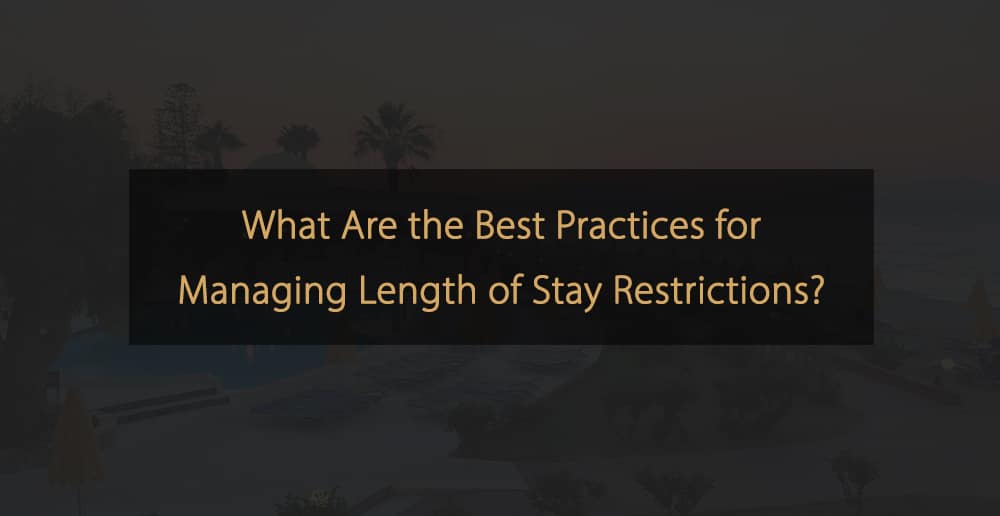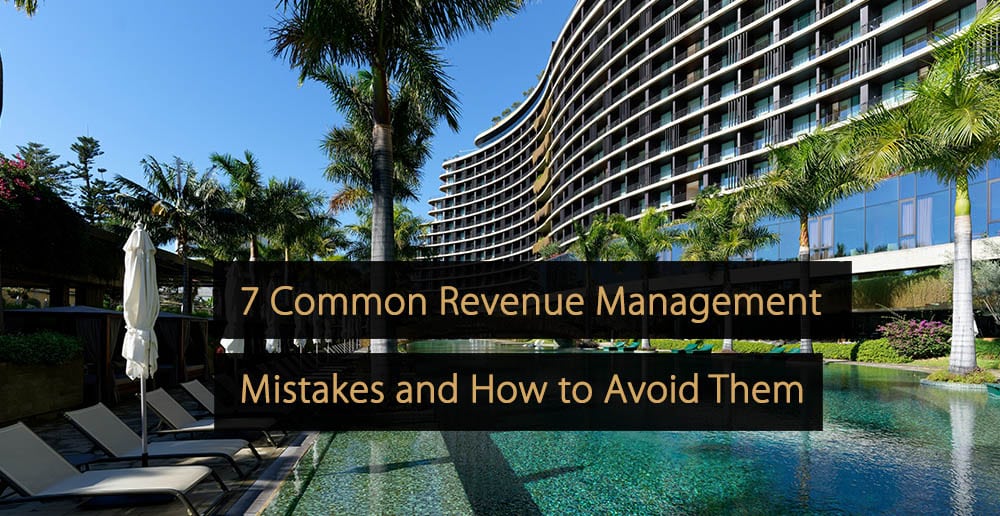Question for Our Revenue Management Expert Panel:
What are the best practices for managing Length of Stay restrictions? What considerations should be given to their usage, and what are the possible risks to avoid? (Question by Niko Krauseneck)
Industry Expert Panel
Our Industry Expert Panel exists out of professionals within the hospitality & travel Industry. They have comprehensive and detailed knowledge, experience in practice or management and are forward-thinking. They are answering questions about the state of the industry. They share their insights on topics like revenue management, marketing, operations, technology and discuss the latest trends.
Our Revenue Management Expert Panel
- Tamie Matthews – Sales & Marketing Consultant, RevenYou
- Connor Vanderholm – CEO, Topline
- Diego Fernández Pérez De Ponga – Director of Revenue Management, Palladium Hotel Group
- Heiko Rieder – Senior Vice President Commercial & Distribution, Step Partners Europe
- Niko Krauseneck – Founder, RevenueRebel
- Massimiliano Terzulli – Revenue Management Consultant, Franco Grasso Revenue Team
- Krunal Shah – Director of Revenue Management, The Biltmore Mayfair, LXR Hotels & Resorts
- Silvia Cantarella – Revenue Management Consultant, Revenue Acrobats
- Pablo Torres – Hotel Consultant
- Mariska van Heemskerk – Owner, Revenue Management Works
- Dermot Herlihy – Owner, Dynamic Hospitality Consulting
- Ask Our Panel a Question
- Join Our Expert Panel
“When considering length of stay restrictions, start with the business goals. What do you want to achieve as the revenue manager and what needs to happen to ensure the success of the business? Sometimes we have to put restrictions in place to control costs and to ensure customer expectations are met. For example: cost of cleaning in serviced apartments being divided over a number of nights stay.
Next you need to consider the market and how it is performing. We may want our guests to stay longer, but maybe they can’t afford it. Maybe our competitors are all offering greater flexibility? Look at the event you are considering the minimum stay for, and analyse whether customers would or should stay for longer. Some event start and end times mean that customers need to stay 2 or more nights.
Consider the event and which customer you want. Sometimes we put a minimum stay on to ensure we get the staff working the event who will stay longer but pay less. We don’t want the 1 night attendee. Whenever you put minimum stays on a specific day, be prepared to review often, and change your strategy according to market demand. Remember, the only constant in life is change itself.”
“Anytime LOS restrictions are implemented, they need to be clearly visible and monitored by the RM regularly. The fastest way to get into a pickle with LOS restrictions is for an RM to set them and then forget about them. A quality RMS will place and remove LOS restrictions for you, but you still need to have these visible in your reports and recommend keeping or removing them once you’ve given them the ole sniff test.”
“I think the most important thing to analyse in a LOS strategy is to know your customer, nationality, and purchasing patterns. There are nationalities that, for various reasons, stay more nights in your hotel. Or nationalities that only come on the weekend and no matter how much you want, they will not visit you for more than two nights. At that point you need to decide if you want that business.
There is a tendency in Revenue Management to look for and control the nights of stay with the price, and prevent a scenario where a client wants to stay only one night. Yes, they can sty, but they can pay much more. So the nights of stay are controlled by creating a price restriction, that means that one night will be 20% (this is an example) more expensive if you only take one night than if you take two.”
“Length of Stay (LOS) restrictions are quite stringent, especially when applied at house level. Therefore, it’s crucial to ensure that demand is sufficiently high, as these restrictions are likely to lead to turning away potential business. The higher the Minimum Length of Stay (MLOS) requirement, the more business is turned away. A softer restriction that can achieve a similar effect is implementing no-arrivals policies.
To mitigate the risk of turn-aways, balancing Day of Week (DOW) patterns in less predictable markets with higher rates can be effective. Guests are usually more willing to pay a higher rate than to book an extra, unnecessary night. This principle applies to all property types, including resort destinations. Ideally, if demand supports selling out every day with an ML7 strategy, that’s perfect. However, if this strategy results in low occupancy, it is often more profitable to accept some nights with low occupancy while others sell out, also considering the potential loss of ancillary revenues.”
“While LOS restrictions are a great tool for inventory management and demand regulation, they need to be handled with care. One has to consider three main arguments:
- you exclude demand
- you are removing the rooms from the display thus reducing any billboard effect
- you are creating a booking barrier for the guest
As a general rule of thumb, I ask myself three questions before setting a LOS restriction:
- is the demand exceeding supply and am I expecting 100% occupancy?
- is there demand for more than one night? (E.g. for sporting events or concerts demand is generally only for one night)
- have I tried increasing the rate?
If any of these questions is answered with “NO”, I will not use a LOS restriction, but handle demand differently instead. These approaches include closing low profit segments, raising the rate, raising OTA or category supplements etc. If I believe a LOS restriction is unavoidable, I will try to limit it on certain channels or categories, thus still being visible on some channels.”
“It’s always preferable to avoid any form of restriction that creates friction in the market (non-refundable policies, minimum stays, restrictive payment policies, etc.). Minimum stays have more disadvantages than advantages; they significantly reduce the market share targeted, implying a decrease in visibility and therefore ranking on OTAs, which can have a negative impact on ADR and occupancy in the long run.
During periods of high demand for a particular date due to a special event, it’s the rate that becomes the main restriction, as it rises consistently with the pickup. A high rate can reduce one-night bookings (due to a very high price) and favour multiple-night stays, as the high amount for the single night with the event is absorbed by the lower rates of other nights. This naturally extends the average length of stay and optimises operational costs.
In exceptional cases with major events (New Year’s Eve, Champions League finals, or other important sports competitions), one might consider implementing a minimum stay if the rate alone, however high, is not sufficient to curb bookings. But these are truly exceptional events; in normal cases, it’s always better to avoid minimum stays. And if you want to incentivise longer stays to optimise costs, it’s better to offer enticing promotions to guests rather than obligations like minimum stays.”
“Length of stay is still frequently abused, especially when it is massively applied at the Hotel level and the forecast and demand (real time) are being neglected. Revenue management uses open pricing much more than LOS, but I believe that LOS is important, especially in hotels that have limited inventory, medium-long stays, unique room or suite types.
LOS management is very widespread, especially in luxury properties which have very peculiar room types. If used carefully and precisely by room type and period, based on demand and forecast, it is very effective in optimising inventory and performance in general.”
“The basis of the answer lies in the analysis of historical data; which days run fastest for your hotel? Do you always fill up a specific weekday? Does that happen last minute, or far out in advance? You need to find out if the market is constrained; is there overdemand and can I push for multiple night stay only?
Hotels tend to place a length of stay restriction on specific days far out in advance – however, in the end, they remove it last minute; so make sure to find your strategy and evaluate. In my opinion, each month needs to be evaluated day by day, from starting price, to length of stay evolvement, to end price on certain days.”
“Length of stay (LOS) restrictions require a very high-demand night or several nights to be successful, such as a concert or sports event. It makes sense to require minimal lengths of stay to fill shoulder nights.
Another example could be a day of the week that is consistently in high demand. For example, Saturday is always sold out, and Friday will only get close to Saturday’s occupancy if a 2-night minimum stay restriction is implemented.
Revenue managers must understand the hotel guests and the market in order to use LOS restrictions successfully. Some questions to ask are:
- Do competitors implement LOS restrictions on these days? Otherwise, you might lose business to the competition.
- Will potential guests accept the required restriction? Guests might tolerate staying on Friday and Saturday but won’t stay on Saturday and Sunday because they have to be at work on Monday.”
Ask a Question & Join Our Expert Panel
Would you like a question to be answered by our Industry Expert Panel? Or would you like to join our community of experts and share your experience, insights, and knowledge with fellow industry professionals? Via the buttons below you can submit a question or submit a request to become part of our expert panel.
More Tips to Grow Your Business
Revfine.com is the leading knowledge platform for the hospitality and travel industry. Professionals use our insights, strategies, and actionable tips to get inspired, optimize revenue, innovate processes, and improve customer experience.Explore expert advice on management, marketing, revenue management, operations, software, and technology in our dedicated Hotel, Hospitality, and Travel & Tourism categories.
















Leave A Comment